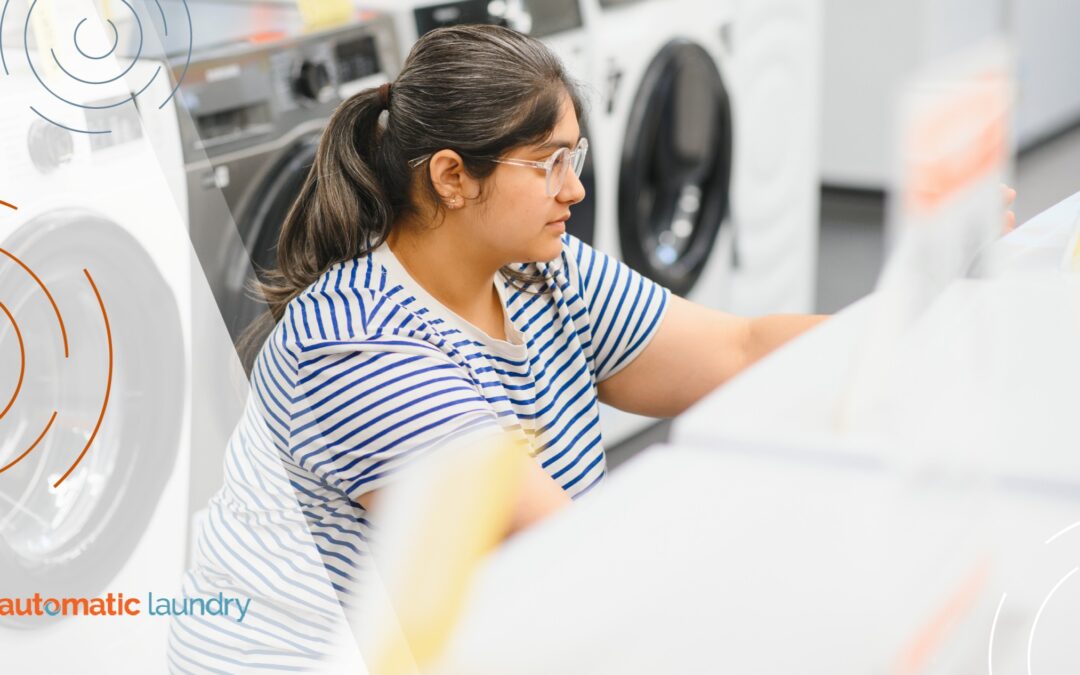In 2025, residents judge a building by everyday touchpoints such as package rooms, parking, and the laundry room. For smaller properties competing on experience rather than endless amenities, a well-executed laundry room design can punch far above its weight: faster turns on machines, fewer service calls, and a calmer space that residents actually like using. Below is a practical framework that is grounded in layout, accessibility, technology, operations, and efficiency to help you shape a better resident experience and a better profit and loss.
1. Layout That Reduces Friction
A good laundry room design begins with thoughtful space planning that encourages smooth traffic flow. When residents have enough room to move comfortably between machines, folding areas, and seating, the experience feels organized rather than chaotic. Adding elements like a utility sink, sturdy folding tables, and a few chairs creates a more functional and welcoming space, helping to reduce congestion and make the room easier to use for everyone.
Beyond square footage, small properties win with simple traffic patterns: bank machines along walls, keep a clear center aisle, and cluster units in 2×2 or 4×4 blocks to prevent pinch points and allow multiple users to work without collisions. A dedicated hanging bar near dryers shortens the “dryer-to-closet” journey and cuts wrinkling. These details seem minor; collectively, they reduce wait times and perceived chaos, which residents remember on lease renewal day.
2. Accessibility and Comfort by Design
Inclusive design is both compliance and good business. The Americans with Disabilities Act (ADA) guidance covers approach clearances, reach ranges for controls, and door swings for washers and dryers serving residential facilities, dorms, and laundromats. Selecting models with reachable controls and maintaining accessible routes isn’t optional, and it widens your prospective renter base while lowering daily friction for all users.
Comfort is equally strategic. According to the WELL Building Standard playbook: ample lighting, cleanable finishes, good air quality, and acoustic control reduce stress and make short waits tolerable. You don’t need certification to apply the principles; brighter task lighting over folding areas and better ventilation can make an ordinary laundry room feel premium and safer.
3. Smart Tools Residents Actually Use
Residents expect app-based convenience. Across major manufacturers, connected washers and dryers now support cycle status, push notifications, and remote starts where applicable, features that reduce the need for residents to constantly monitor their laundry and lower complaints. If you serve multiple demographics or off-peak users, cycle-complete alerts and “door not opened” reminders help people move loads on time, preventing the common frustration of finding someone else’s forgotten laundry occupying machines during peak hours.
For properties partnering with a service provider, a dedicated app such as LaundryConnect™ Pay lets residents start machines, add funds, see real-time availability, and trigger service requests, all of which shorten learning curves for new tenants and reduce staff intervention. Clear signage that points to the app, a posted QR code, and a line in the move-in packet drive adoption from day one.
4. Operations, Transparency, and Right-Sizing
Great resident experience depends on back-of-house clarity. Cloud dashboards and modern payment kiosks reduce coin handling, surface usage patterns, and speed dispatch when issues occur; the result is fewer down machine days and better accountability. Several multi-housing references recommend right-sizing machine counts to your building type—e.g., one washer/dryer pair per 6–8 units in garden-style or per 15–20 units in high-rise; other guides suggest one pair per 8–12 units in decentralized setups. When you hit the ratio, residents notice the shorter waits more than any poster on the wall.
According to the Bureau of Labor Statistics, government data supports the broader principle that education and proper procedures matter. Research from the Monthly Labor Review highlights that identifying factors which “can be addressed through training and prevention techniques, can help reduce workplace injuries.” While the data is workplace-focused, the same principle applies to laundry room operations, where proper resident guidance and preventative maintenance significantly reduce equipment-related incidents and costly downtime.

5) Efficiency That Lowers Costs and Noise
Equipment choice is a key part of design. ENERGY STAR reports that certified full-size washers use about 14 gallons of water per load, compared with 20 gallons for standard models. Commercial ENERGY STAR units are nine percent more energy efficient and use 45 percent less water than non-certified machines. Across hundreds of loads, these savings translate into lower utility costs and less moisture to manage in a compact laundry room.
Front-load platforms typically reduce water and shorten dryer time, improving throughput—an advantage in small rooms where queues form fast. EPA materials summarize that front-load ENERGY STAR washers are about 25% more efficient than even high-efficiency top-load washers. For tight spaces, stackable front-load pairs also free floor area for folding and seating, improving the perceived quality of the room.
Conclusion
Property managers cannot afford to overlook how laundry room design impacts resident satisfaction and operational efficiency. From creating layouts that minimize wait times to integrating smart payment and monitoring systems, well-planned laundry spaces deliver long-term value to both residents and owners. Communities that prioritize thoughtful design not only reduce service issues but also gain a competitive edge in attracting and retaining tenants. Contact us today to learn how Automatic Laundry services can help transform your property with laundry room design that enhances experience, streamlines operations, and supports lasting resident loyalty.


